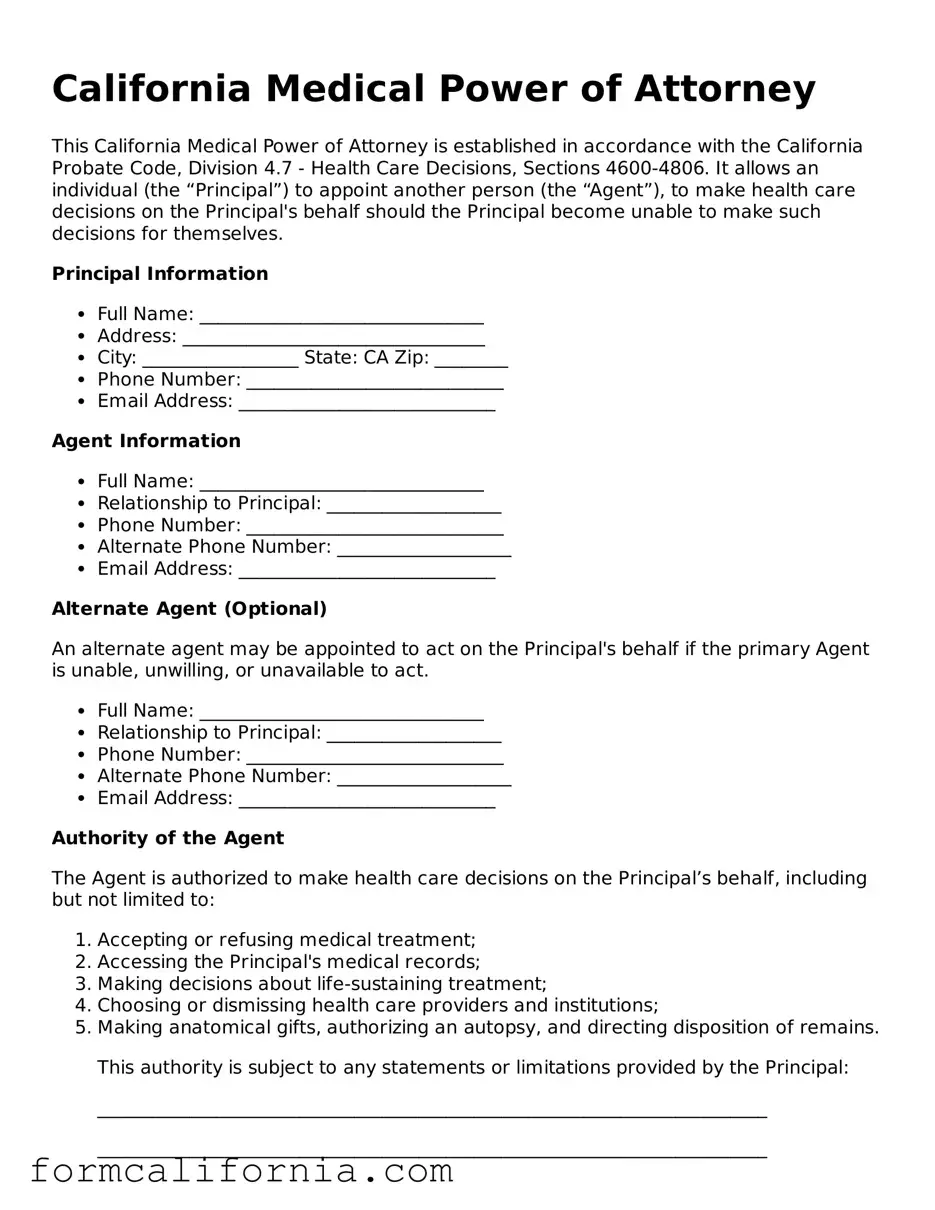The California Medical Power of Attorney (MPA) shares similarities with a variety of other legal documents, each designed to manage aspects of a person's life under specific circumstances. One such document is the Advance Healthcare Directive (AHCD). Like an MPA, an AHCD allows an individual to outline their healthcare preferences and appoint a trusted person to make medical decisions on their behalf if they become unable to do so themselves. Both documents are proactive steps in healthcare planning, ensuring that the individual's wishes are respected.
Another document closely related to the California MPA is the Durable Power of Attorney for Finances (DPOA-F). While an MPA focuses on healthcare decisions, a DPOA-F gives someone the authority to manage financial matters. This might include paying bills, managing investments, or making real estate transactions. The "durable" nature of both documents means they remain in effect even if the person who made them loses mental capacity.
The Living Will, also known as a directive to physicians, is a document that complements the MPA by providing specific instructions about end-of-life care. While an MPA nominates a healthcare agent to make decisions broadly, a Living Will might specify wishes regarding life-prolonging treatments, palliative care, or organ donation. Both documents serve to guide healthcare providers when the person who created the documents cannot communicate their preferences directly.
A General Power of Attorney (GPA) also bears resemblance to an MPA, but with a broader scope. A GPA grants an agent the power to act in a variety of circumstances, not just medical or health-related issues. However, unlike an MPA, the authority granted by a GPA typically ends if the principal becomes incapacitated, unless it is specified as durable.
The HIPAA (Health Insurance Portability and Accountability Act) Authorization form is another document related to the MPA. It permits healthcare providers to disclose an individual's health information to designated persons or entities. While an MPA designates who can make decisions about an individual's healthcare, a HIPAA Authorization specifies who can receive private health information, facilitating informed decisions by the agent.
The Psychiatric Advance Directive (PAD) is a specialized form of healthcare directive that focuses on mental health care preferences. Like an MPA, a PAD allows individuals to outline treatment preferences and appoint an agent to make decisions on their behalf in the event of incapacitation due to mental illness. This document is crucial for individuals who have specific wishes regarding psychiatric care, medication, or hospitalization choices.
The Conservatorship is a court-ordered arrangement that can resemble the effect of an MPA in some respects. When a conservatorship is established, a judge appoints a conservator to make personal and/or financial decisions for a conservatee who is unable to do so on their own, possibly due to mental incapacity. Unlike an MPA, which the individual voluntarily establishes, conservatorship is a legal process initiated by others when deemed necessary.
A Do-Not-Resuscitate (DNR) Order is a medical order signed by a physician, instructonsis similar to a segment within an MPA or a Living Will that might address the same issue. A DNR specifically directs healthcare providers not to perform CPR if a person's breathing stops or if their heart stops beating. While an MPA assigns decision-making power, a DNR is a direct medical order, highlighting a specific aspect of a person's healthcare wishes.
Finally, the POLST (Physician Orders for Life-Sustaining Treatment) Form, like a DNR, is a medical order that outlines a patient's preferences for end-of-life care, including treatments they want or do not want. Although similar in purpose to directives within an MPA regarding end-of-life decisions, a POLST is typically for individuals with serious health conditions and is used to guide immediate emergency medical personnel and healthcare providers.
These nine documents, each with its unique function, collectively ensure that individuals can comprehensively manage their healthcare, financial affairs, and personal wishes with clarity and authority. Understanding the nuanced differences and connections among them enables individuals to plan effectively for the future, safeguarding their well-being and autonomy.
